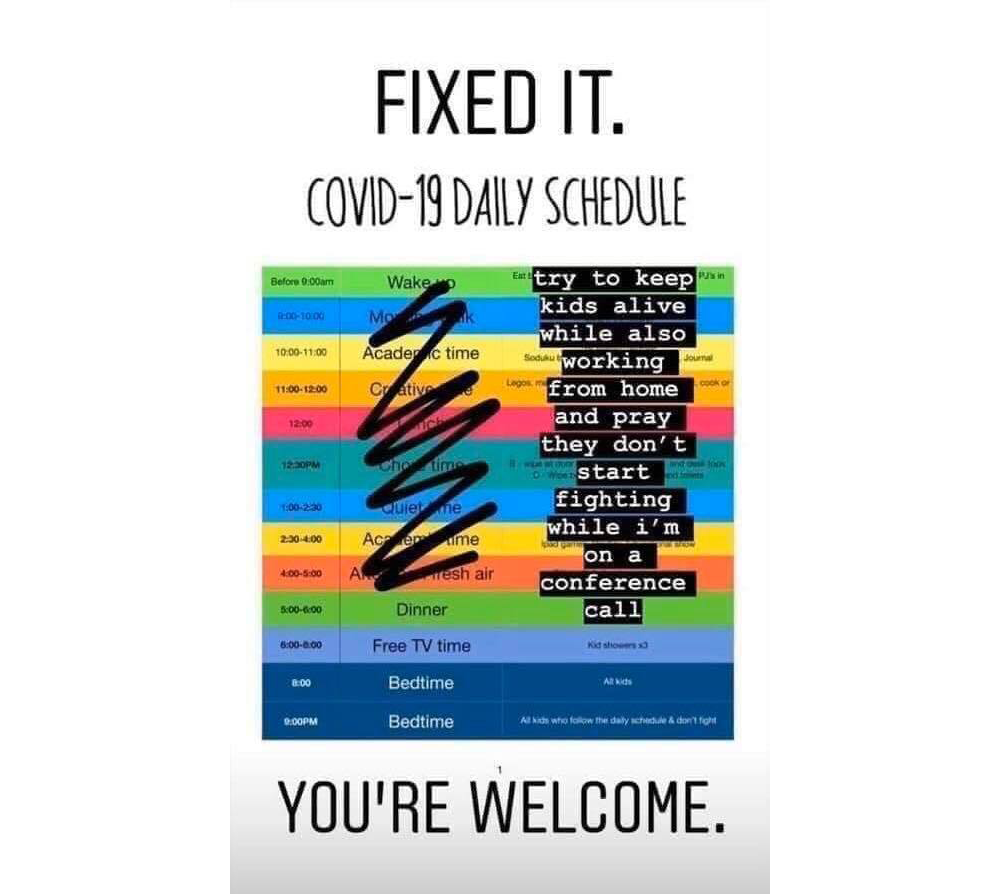
Since publishing “Daddy School,” I’ve gotten a ton of emails.
“How is the homeschool schedule working, and what have you changed after a few days?
Usually, they attach a meme like this one.

As always, there’s important truth in a meme: Don’t try for an A in this situation! That’s nuts. Aspire to a B− as a parent teacher.
After three days, here were my ratings on a scale from one to ten, from my nine year old and eleven year old:
Day 1: 5.0
Day 2: 8.5
Day 3: 7.0
So I’m hitting my second goal, which was the following:
The kids will remember it fondly five years from now. “Remember when we had Daddy School for a few weeks? That wasn’t horrible!”
Anything above a six and I’m happy. That’s B− territory.
What about my first goal? That was the following:
Something reasonably easy for me and sort of fun. I’m not lazy, per se. Okay, I am lazy. I don’t want to do a ton of prep.
My prep has averaged thirty minutes per day. So far, so good.
Finally, my third goal was the following:
Kids learn a little. But in scheme of things, whether they learn a little or a lot doesn’t matter much. A one-month closure is less than 1 percent of their K–12 career.
We’re exceeding this low bar. Learning has gone better than I (and they) expected. Let me break it down.
9 to 9:30: Oversimplified history videos (with lots of pause and cold call)
These videos create a positive start to the day. First, they’re funny. Second, we’re comfy, on the couch. Third, they work, even though each kid starts with a different level of knowledge.
In my “pretest” (“Tell me about the Civil War”), the fourth grader explained it was (ahem) between “the British and the Americans.” She had never heard of Robert Lee, “Confederates,” and so on. So she’s gained lots of basic plot/facts.
The sixth grader knew the basics but gained both facts (Sherman’s March, 13th amendment, Dred Scott, and the definition of “abolition”) and ideas (that a president might need to replace generals, for example, or the tactic of flanking).
I pause the video and cold call on the kids about once per minute. That’s mostly to help the kiddos remember stuff but also to connect to the past to the present (for example, the video describes how Abe Lincoln’s reelection campaign affected his war strategy—a timely concept).
9:30 to 10: Math
Khan Academy Math has productively occupied my sixth grader. Though I want to do more with him one on one, his ability to do Khan solo has freed me to work alongside my fourth grader.
As a side note, I’ve long said that schools mostly have these online math tools backwards: they’re great at helping strong math students, who need little help, but bad at helping weak math students, because the “online tips” can’t get them unstuck. This “solo use case” has the educational advantage of working well but the political disadvantage of expanding the achievement gap, rather than reducing it.
I’d ordered an MCAS Workbook. Thanks to the wonders of Amazon, it arrived right away. The fact that my daughter perceives the book as “official” helps me get her to plod through it.
I have learned a lot about her math skills by “watching over her shoulder” as she works on problems. One thing has jumped out: Although she’s been introduced to fractions, decimals, and percentages, she’s not fluent with them. For example, “What is two-fifths as a decimal?” is a hard question for her.
So I break up our thirty-minute session this way:
• Ten minutes of the workbook, usually solving five questions.
• Ten minutes of me drawing pie graphs, asking her for a fraction and then the decimal and percentage equivalent. I start with a couple questions I know she’ll get, from the day before, to build her confidence. At the ten-minute mark, I’m hitting her limit.
• Ten more minutes of the workbook.
10 to 10:30: Nonfiction book club Silent reading
My book club Idea failed on day one. The kids didn’t agree on a book. The mood declined fast, so I punted.
The nine year old found a nonfiction book she liked in sixty seconds: My Corner Of The Ring. We downloaded it onto Mom’s Kindle. She curled up (and went back to it that afternoon for another sixty pages).
The eleven year old was a little bit irritated. I got him to download a free chapter of The Boys Who Challenged Hitler. That free chapter offer is amazing: easy to convince a kid to “just try it.” He liked it, so he’s off and running.
In hindsight, the silent reading works way better than book club for me. The thirty minutes is now “me time”: a few emails, a few cleared dishes, another cup of coffee. This leads to a slightly more cheerful me, which remains a key driver of the daily rating. Plus, silent reading still accomplishes nonfiction reading and “protects fiction” for afternoon leisure reading (where both kids have a few books going).
10:30 to 10:45: Snack and nerf basketball
Besides a few questionable goaltending calls and running out of “spreadable butter,” this has been smooth.
10:45 to 11:15: Ted Talks (with pause and cold call)
Not bad, but not great (so far). “10 Ways To Have A Better Conversation” dragged a bit, but we managed some good discussion. “A Life Lesson From A Volunteer Firefighter” was short and sweet.
This is an area where perhaps I should prep better. If we watch the first minute of three different Ted Talks (like a movie trailer) and they could pick one to watch the “whole thing,” then I bet engagement would rise.
11:15 to 11:45: Science videos
“Why Is The Solar System Flat,” from MinutePhysics, was too abstract. Again, there’s a tradeoff of prep: I could have used this tool if I’d watched it, figured out what background knowledge the kids needed, explained that to them, and then watched the video. You know, like a real science teacher. But that’s a lot of work.
“How This River Made Chimps Violent,” from MinuteEarth, worked better for us. You don’t need much background knowledge, and enough little jokes were peppered in to hold their attention.
“Bullet Ants”from The Brain Scoop was snappy but a little scary for one of us.
Mark Rober’s “Feeding Bill Gates a Fake Burger,” found via a link from Mike Petrilli, was okay on the science side but (accidentally) pushed us more on the ethics side: reflecting on our meat consumption.
And just like when we watched history videos, my antenna went up a bit as I realized our fourth grader didn’t know the solar system. For months, my wife and I have channeled Hirsch in intent—we might say while out for a stroll, “Hey, we really should get D to learn more knowledge”—but haven’t done much about it. Corona-schooling is making me hyperaware of this shortcoming.
“11:45 to 11:55: “Test for treats”
I’ve mixed questions about our lessons with team challenges like, “Make this putt from ten feet” and “How many free throws can the two of you make in thirty seconds?” They get “sweet treats” every fifty points—gummy worms and ice cream sandwiches—and they’re earning roughly twenty points per morning.
11:55 a.m. to noon
Kids rate the day of Daddy School. It’s been helpful! Sometimes attending to the smallest of details can make a big difference. I want to generate some satisfaction gains in the coming days, to save up for a rainy day: I suspect time will erode their buy in, as the weeks at home perhaps turn into months.
Bonus: For more on balancing structure and buy in see Maia’s blog here, the “Pandemic Parent.”
Mike Goldstein is the founder of Match Education in Boston.
This post originally appeared in Flypaper.
Read more from Education Next on coronavirus and Covid-19.


